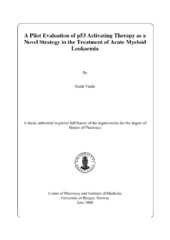| dc.description.abstract | p53 is a tumour suppressor protein involved in maintenance of genomic stability of the cell. Primarily, p53 protects the cell from malignant transformation through cell cycle arrest and apoptosis. While mutations in p53 occur in less than 10% of acute myeloid leukaemia (AML), over-expression of the main negative regulator of p53, MDM2, is frequently observed, representing a mechanism of p53 silencing. Furthermore, aberrant recruitment of histone deacetylases (HDACs) is also seen in AML, leading to block of myeloid differentiation. HDACs deacetylate histones and transcription factors such as p53, leading to increased chromatin compaction, representing an additional means for silencing p53 activity. In this study, we have evaluated the effect of a combination of two drugs affecting the regulation of p53 in AML cells; nutlin-3 and valproic acid (VPA). Nutlin-3 is a non-genotoxic MDM2 antagonist, which specifically disrupts the MDM2-p53 interaction by binding to the p53 specific site on MDM2. This leads to activation of p53 and the p53 pathway in cancer cells with wild type p53, subsequently inhibiting tumour growth. VPA is a well-tolerated non-genotoxic HDAC inhibitor inhibiting deacetylation of chromatin and transcription factors such as p53, and has been found to show an anti-leukemic effect in AML patients. These two therapeutic compounds both indirectly activate p53, thereby presenting a combinational non-genotoxic p53 activation strategy, in contrast to conventional chemotherapy and bone marrow transplantation. Nutlin-3 and VPA in combination was found to show a synergistic effect in vitro in an AML cell line expressing wild type p53 (MOLM-13). An imageable MOLM-13 AML xenograft mouse model was then successfully developed to enable evaluation of the combinational therapeutic strategy in vivo using optical imaging. Nutlin-3 and VPA combined was found to delay AML development and increase survival in vivo. These pilot results suggests the p53 activating strategy as a valuable concept in the treatment of AML, and should indeed be further evaluated. | en_US |
